You want a fast, legal way to get generic clindamycin online without overpaying. The catch? Clindamycin is a UK prescription-only antibiotic, and it carries higher risk of serious gut side effects than many alternatives. So the goal isn’t just “cheap.” It’s getting the right product for the right case, through a licensed UK pharmacy, at a fair price-while avoiding sketchy websites that push antibiotics without a prescription.
Here’s what you’ll find below: what you can and can’t buy online in the UK, how to verify a legit pharmacy in two minutes, real-world price ranges and ways to save, the red flags that mean “close the tab,” and the closest alternatives your prescriber may prefer. If you already have a valid prescription (from your GP or an online prescriber), you can buy clindamycin online in the UK safely-provided the pharmacy is licensed and you pass a quick screening.
What You Can Actually Buy Online (UK): Forms, Uses, and What Prescribers Approve
Quick reality check. In the UK, clindamycin (Dalacin C for capsules; clindamycin phosphate for gels/lotions) is prescription-only. A legit online pharmacy will require either a prescription upload or an online consultation reviewed by a UK-registered prescriber. No RX, no sale. If a website says otherwise, it’s a red flag.
Common UK forms you may see from licensed online pharmacies:
- Oral clindamycin capsules (typically 150 mg and 300 mg) - used for certain serious bacterial infections. Often reserved when penicillins or other first-line antibiotics aren’t suitable.
- Topical clindamycin 1% (gel/lotion/solution) - primarily for acne, usually combined with benzoyl peroxide to reduce resistance. NICE guidance advises against antibiotic-only gels for acne.
- Clindamycin 2% vaginal cream - for bacterial vaginosis in selected cases, often alongside or as an alternative to metronidazole, based on prescriber judgment.
Where clindamycin fits (and where it doesn’t):
- Skin and soft-tissue infections: Sometimes used if you’re allergic to penicillins or if other antibiotics aren’t appropriate.
- Dental infections: Less common than it used to be, because of C. difficile risk. UK dental guidance now favours other options first.
- Acne: Topical clindamycin may be used short-term but usually with benzoyl peroxide, never as monotherapy, and not long-term. For moderate acne, prescribers may prefer lymecycline or doxycycline plus topical retinoid/BPO.
- Bacterial vaginosis: Metronidazole is typically first-line; clindamycin cream is an alternative in selected situations.
Bottom line: If a site pushes oral clindamycin as a quick fix for everyday issues (like simple sore throats or mild acne), that’s not aligned with UK guidance. Antibiotic stewardship matters-overuse fuels resistance and raises your risk of nasty side effects.
How to Buy Online Safely in the UK (And Avoid Rogue Pharmacies)
There are only two safe routes: upload a valid UK prescription to a licensed online pharmacy, or complete an online consultation assessed by a UK-registered prescriber who then issues a prescription if appropriate. Anything else risks fake meds or illegal supply.
Two-minute verification checklist:
- GPhC registration: Check the pharmacy’s General Pharmaceutical Council number and confirm it on the GPhC register.
- MHRA distance selling logo: Click it; it should take you to the MHRA page confirming the pharmacy is authorised to sell medicines online.
- Named prescriber: The site should show the name and GMC/NMC/GPhC registration of the prescriber(s).
- Real UK address and customer support: No address or vague contact details equals risk.
- Prescription process: A proper questionnaire that asks about symptoms, allergies, conditions, and current meds. Instant “add to cart” for antibiotics without assessment is a no.
What legitimate sites never do:
- Sell clindamycin without a prescription or consultation.
- Ship prescription antibiotics from outside the UK to UK customers to dodge rules.
- Offer unbelievably low prices or bulk deals on antibiotics.
- Hide behind PO boxes, offshore entities, or anonymous ownership.
Step-by-step (UK):
- Confirm the pharmacy’s GPhC registration and MHRA logo.
- Pick the form you actually need (oral vs topical vs vaginal). If unsure, start with a consultation rather than guessing.
- Complete the medical questionnaire accurately. Mention allergies (especially penicillin), gut issues, liver disease, pregnancy/breastfeeding, and all medicines you take.
- Upload ID if asked. Some pharmacies verify age/identity for prescription supply.
- Review the total cost (medicine + prescription fee + delivery) before paying.
- On delivery, check the patient information leaflet, batch number, and expiry date. Keep the packaging until the course is finished.
Prices, Delivery, and Real Ways to Save Without Cutting Corners
Online prices vary by strength, pack size, and whether the site charges a separate prescriber fee. These are typical UK private prices seen in 2024-2025 on licensed sites; they change with supply and wholesaler costs:
| Product (UK) | Typical Private Online Price (2025) | Notes |
|---|---|---|
| Clindamycin capsules 150 mg (24-28 caps) | £9-£18 | Generic; price varies by wholesaler and prescriber fee structure |
| Clindamycin capsules 300 mg (21-28 caps) | £12-£24 | Generic; sometimes slightly higher due to strength |
| Topical clindamycin 1% gel/lotion (30-60 g) | £8-£20 | Often paired with benzoyl peroxide per NICE guidance |
| Clindamycin 2% vaginal cream (with applicators) | £12-£25 | Availability varies; prescriber may prefer metronidazole first |
| Prescription/consultation fee | £0-£30 | Some pharmacies include it; others charge separately |
| Delivery (UK mainland) | £0-£4 (standard) | Tracked 24/48 often £3-£6; free over a spend threshold |
NHS angle: If you’re in England and get clindamycin on the NHS, you pay the standard prescription charge per item (set by the Department of Health and Social Care). In 2024 it was £9.90; it may change, but it’s often cheaper than private-if your GP agrees it’s indicated. In Scotland, Wales, and Northern Ireland, NHS prescriptions are free at the point of use.
How to pay less without risking junk meds:
- Go generic: Clindamycin is an off-patent generic. Brand names cost more for the same ingredient and effect.
- Right pack size: Don’t overbuy. Online prescribers should match the course length to guidance for your condition.
- Combine care: For acne, using a combo gel (e.g., clindamycin + BPO) might reduce the need for oral antibiotics and repeated purchases.
- Delivery timing: Standard delivery is usually fine for non-urgent treatments; paying extra for same-day rarely helps.
- Check if the site includes the prescriber fee: All-in-one pricing can make two sites with similar “medicine” prices differ by £10-£30.
Delivery expectations: Most licensed UK pharmacies ship via Royal Mail Tracked 24/48 or a similar courier. Expect 1-3 working days. Refrigeration isn’t needed for clindamycin. Pharmacies generally can’t ship prescription meds internationally; it’s UK-only.
Risks, Side Effects, and Red Flags You Shouldn’t Ignore
Clindamycin works well when used appropriately, but it’s not a “lightweight” antibiotic. The biggest concern is antibiotic-associated colitis caused by C. difficile. UK safety communications and the British National Formulary highlight this risk. If you develop severe, persistent, or bloody diarrhoea-even weeks after you finish-stop taking clindamycin and seek urgent medical help.
Common side effects:
- Nausea, vomiting, diarrhoea, tummy pain.
- Metallic taste (less common with oral), dry skin or irritation with topical forms.
Serious side effects (get help immediately):
- Severe diarrhoea or signs of colitis (fever, cramping, blood/mucus).
- Allergic reaction (rash, swelling, wheeze, difficulty breathing).
- Severe skin reactions (rare): blistering or peeling skin, mouth ulcers.
Interactions and cautions worth flagging to the prescriber:
- Warfarin and other anticoagulants: Antibiotics can alter gut flora and vitamin K metabolism, affecting INR. Monitoring may be needed.
- Erythromycin: Can antagonise clindamycin’s effect; prescribers avoid combining.
- Neuromuscular blockers: Clindamycin can enhance their effects (relevant around surgery/anaesthesia).
- History of colitis or severe gut disease: Extra caution or a different antibiotic may be chosen.
- Liver issues: Dose adjustments and monitoring may be considered.
Pregnancy and breastfeeding: Topical clindamycin is often considered when needed in pregnancy; oral use is by prescriber decision only. During breastfeeding, small amounts may pass into milk; watch for diarrhoea or thrush in the infant and follow your clinician’s advice. Always disclose pregnancy/breastfeeding status in the online consultation.
How to take it safely (general, not individual medical advice):
- Swallow capsules with a full glass of water and stay upright for 30 minutes to reduce oesophageal irritation.
- Take doses evenly spaced, exactly as prescribed. Don’t double up if you miss one-ask your pharmacist what to do.
- Never save leftover antibiotics. If your symptoms don’t improve as expected, contact a clinician instead of extending the course yourself.
Don’t buy if you see these red flags on a website:
- “No prescription needed” for antibiotics.
- Prices that look too good to be true or bulk antibiotic discounts.
- No GPhC/MHRA credentials or non-clickable logos.
- Ships from outside the UK or won’t show a UK address.
- Pushy claims like “cures all infections” or “side-effect free.”
| Scenario | What to do |
|---|---|
| You develop severe diarrhoea on clindamycin | Stop the medicine and seek urgent medical help; mention clindamycin to the clinician |
| The site offers oral clindamycin without any consultation | Leave the site; it’s not compliant with UK law or safety standards |
| Your acne hasn’t improved after 12 weeks on topical clindamycin | Speak to a prescriber; NICE recommends reassessing and avoiding long-term antibiotic monotherapy |
| You’re on warfarin and have been prescribed clindamycin | Ask about INR checks and watch for bleeding/bruising; follow clinician advice |
Credible sources behind this guidance include the NHS, the British National Formulary (BNF), the Medicines and Healthcare products Regulatory Agency (MHRA), the General Pharmaceutical Council (GPhC), and NICE acne management guidelines.

Alternatives Your Prescriber May Prefer-and When
Because clindamycin carries a higher C. diff risk, many UK prescribers use it when other options aren’t suitable. Depending on your condition, these alternatives may be considered first:
- Skin/soft-tissue infections: Flucloxacillin (if not allergic), doxycycline, or clarithromycin are common choices; clindamycin is often a second-line option.
- Dental infections: Amoxicillin or metronidazole are typical first-line choices; clindamycin is less favoured now.
- Acne: Topical benzoyl peroxide + adapalene; short-term antibiotic use (topical or oral) only when needed and never alone; lymecycline or doxycycline are frequent oral options.
- Bacterial vaginosis: Metronidazole (oral or gel) is usually first-line; clindamycin cream is an alternative in certain cases.
How clindamycin compares:
- Effectiveness: Strong against certain Gram-positive and anaerobic bacteria; excellent tissue penetration.
- Safety trade-off: Higher risk of C. diff than many alternatives; prescribers weigh this alongside allergy history and infection type.
- Convenience: Capsules multiple times daily; topical forms once/twice daily; adherence matters.
If cost is your main driver and an alternative antibiotic is equally effective and safer for your case, a prescriber will typically choose the alternative. That’s the right move.
Ethical Call to Action: Do This Next
Here’s the clean, safe path in the UK:
- If you already have a UK prescription: Use a GPhC-registered online pharmacy with the MHRA distance selling logo, upload your script, and compare total costs (medicine + consult fee if any + delivery).
- If you don’t have a prescription: Complete an online consultation with a licensed UK service. Be honest and thorough so the prescriber can decide if clindamycin is right-or if a safer alternative fits.
- If you’re unsure you even need clindamycin: Book a GP or pharmacist consultation. For acne and BV, there are often first-line options that are cheaper and safer.
Pro tips before you pay:
- Double-check the site on the GPhC register and click through the MHRA logo-don’t just trust a badge.
- Confirm what’s included in the price: Is the prescriber fee bundled? What’s the delivery speed?
- Read the patient information leaflet upon arrival. Keep the packaging until you finish the course.
As someone who orders legitimate medicines online from Bristol, the best habit I’ve learned is this: trust the process, not the promise. If a site removes the safety steps, it removes the safety.
FAQ
Can I get clindamycin without a prescription in the UK?
No. Oral, topical, and vaginal clindamycin are prescription-only medicines. Any site offering it without a prescription is not operating legally or safely.
Is generic clindamycin as good as the brand?
Yes. UK generics must meet strict bioequivalence standards. You get the same active ingredient and effect for less.
How fast will a legit UK pharmacy deliver?
Typically 1-3 working days with Royal Mail Tracked 24/48 or a courier. Same-day may be available in some cities at extra cost.
What if clindamycin upsets my stomach?
Mild nausea can happen. Severe or persistent diarrhoea is not normal-stop the medicine and seek urgent advice due to C. diff risk.
Can I drink alcohol with clindamycin?
Alcohol doesn’t directly interact like it does with metronidazole, but if you’re unwell or nauseated, avoiding alcohol is sensible.
Is clindamycin safe in pregnancy?
Use only if a clinician thinks benefits outweigh risks. Topical forms are often considered when needed; always disclose pregnancy status.
What if I’m allergic to penicillin?
Clindamycin is sometimes used in penicillin allergy, but your prescriber will weigh safer alternatives first where possible.
Next Steps and Troubleshooting
If you’re ready to proceed safely:
- Verify the online pharmacy on the GPhC register and MHRA distance selling list.
- Decide the form you need (oral/topical/vaginal) based on your condition-if unsure, choose the consultation route.
- Compare total costs (medicine + consult fee + delivery).
- Complete the questionnaire honestly; include all meds and conditions.
Troubleshooting different scenarios:
- Price seems high: Check if prescriber fee is included, switch to generic, or look at a different licensed pharmacy. Ask your GP about an NHS prescription if appropriate.
- Website looks shady: No GPhC number, no MHRA logo, or “no prescription needed” claims-leave immediately.
- Symptoms not improving: Don’t extend the course or change the dose yourself. Contact the prescriber; you may need a different diagnosis or antibiotic.
- Side effects: For mild issues, speak to a pharmacist about supportive care. For severe diarrhoea, allergic signs, or chest symptoms-urgent care now.
Key references that guide this advice: NHS medicines information, BNF monograph for clindamycin, MHRA distance selling regulations, GPhC standards for registered pharmacies, and NICE acne guidelines. Use them as your compass, and you’ll get safe treatment at a fair price without feeding the counterfeit market.





Mithun Paul
August 22, 2025 AT 01:35GPhC and MHRA checks are non-negotiable when buying prescription antibiotics online.
Click the GPhC number and verify the MHRA distance-selling logo every single time before uploading any prescription. Trackable delivery and a visible UK address are simple signs that the site follows regulations and can be audited if something goes wrong.
Do not bypass the consultation step; a legit prescriber will screen for previous gut disease, recent antibiotic use, and warfarin or other interacting drugs.
Keep receipts, batch numbers, and the patient information leaflet until the full course is finished in case adverse effects show up later.
Roger Cardoso
August 23, 2025 AT 02:46Too-good-to-be-true prices on antibiotics usually are too good to be true for a reason.
Many of those bargain sites are part of offshore supply chains that dodge UK rules and ship generics of uncertain provenance. The lack of a named prescriber, a non-clickable MHRA badge, or a foreign shipping origin are all consistent markers of a dodgy operation.
Buying from such places risks counterfeit or substandard medicine and contributes to resistance by letting antibiotics circulate unchecked. Stick to verified UK providers and treat price differences as a small insurance premium for safety.
Sandy Martin
August 24, 2025 AT 03:58Topical clindamycin for acne needs to be paired with benzoyl peroxide to reduce resistance and boost results.
When I switched to a combined product after months of spotty improvement, the regimen actually cut down on breakouts and shortened the time I needed oral antibiotics. Mentioning past treatments and any retinoid use on the consultation form helps the prescriber tailor the plan correctly.
Also, keep an eye out for skin irritation early on and stop use if severe redness or blistering appears; a pharmacist can suggest alternatives if needed.
Steve Smilie
August 27, 2025 AT 15:06Antibiotic stewardship isn't some dry policy line - it's the only thing standing between effective meds and a future where simple infections become dangerous again.
Clindamycin has a real reputation for causing C. difficile, so prescribers reserving it for clear indications makes clinical sense and protects the wider community. If you try to game the system for quick private access, you end up undermining that communal safety net.
Buy with responsibility, follow the course exactly as prescribed, and refuse to take leftover pills from the medicine cabinet for new problems.
Josie McManus
August 31, 2025 AT 02:26Topical combo treatment actually helped me way more than just using antibiotic gel alone.
I started with the gel alone and saw little change, then switched to a clindamycin+BPO combo after an online consult and saw steady improvement. Sticking to the application schedule and not over-layering products matters a lot.
Janice Rodrigiez
September 3, 2025 AT 13:46Always prioritise licensed provision over price when it comes to antibiotics.
Start with the verification steps: check the GPhC register for the pharmacy number and confirm the MHRA distance-selling logo leads to the regulator's page. Next, read the online consultation carefully and answer honestly about allergies, pregnancy, breastfeeding, liver disease, past C. difficile, and all current medications. The prescriber needs that context to choose safely between oral, topical, or vaginal clindamycin or an alternative.
If a site offers instant add-to-cart for oral antibiotics with no questions, close the tab immediately. Legitimate services will ask targeted clinical questions and may request ID or previous prescriptions.
For acne specifically, short courses of topical clindamycin should be paired with benzoyl peroxide and reviewed within 12 weeks. Long-term antibiotic monotherapy is discouraged in guidance for resistance reasons.
When you upload a prescription, confirm the pack size matches the intended course length and that the pharmacy includes a medicine leaflet with batch and expiry details. Keep those details until the course is complete in case you need to report an adverse reaction.
Price-saving tips that don't compromise safety: choose generic formulations, select the correct pack size rather than bulk, compare total cost including the prescriber fee, and use standard tracked delivery for non-urgent needs. Avoid free-shipping thresholds that push you into buying more medicine than you need.
Pregnancy and breastfeeding require disclosure on the consultation form because prescribers might prefer topical agents or entirely different antibiotics depending on the risk-benefit calculation. For warfarin users, the prescriber should note the need for INR monitoring if an interacting antibiotic is started.
Storage and administration basics: capsules do not require refrigeration, swallow with water, and remain upright for a short time to reduce throat irritation. Do not save leftovers or share antibiotics with anyone else; doing so is clinically unsafe.
Be vigilant for red-flag side effects. Severe or bloody diarrhoea, high fever with cramping, or severe skin reactions require immediate medical attention and stopping the antibiotic. Mild nausea or transient GI upset is common, but persistent symptoms are not normal.
If symptoms don't improve within the expected timeframe, do not extend or alter the regimen yourself. Contact the prescriber; there may be alternative diagnoses or a need for a different antibiotic based on culture results or clinical review.
Finally, keep records: the prescription image, order confirmation, batch number, expiry date, and the patient leaflet. Those details are crucial if you need to report a suspected counterfeit or adverse event to MHRA.
Treat antibiotics as clinically powerful tools, not commodities. Safe access is about process and transparency, not just price or convenience.
barry conpoes
September 4, 2025 AT 17:33NHS pathways beat private internet pharmacies for trust every time.
When GPs issue a prescription on the NHS, it keeps supply transparent and ensures follow-up is straightforward. Privatizing access to antibiotics turns a regulated clinical decision into a shopping exercise and that is not an improvement for public health.
Kristen Holcomb
September 8, 2025 AT 04:53Practical support matters alongside the high-level stance on NHS care.
For people who genuinely need faster access, use a licensed UK online clinic that links prescriptions back to NHS records where possible. That keeps a clear clinical trail and avoids fragmenting care across anonymous providers.
Also, pharmacists can often advise on topical options and over-the-counter measures while you wait for a GP appointment, which reduces unnecessary oral antibiotic use.
justin davis
September 9, 2025 AT 08:40Same-day antibiotics with no checks - wow, such progress, much trust, very safe!!
Heather Kennedy
September 12, 2025 AT 20:00Prescription charges differ across the UK, so always confirm whether an NHS prescription or a private purchase is cheaper for you.
In England a per-item NHS charge may still be less than the private total once prescriber fees are included, while Scotland, Wales and Northern Ireland have no routine prescription charge. Mention this on the consultation if cost is a real constraint so the clinician can consider NHS options where appropriate.
Roger Cardoso
September 16, 2025 AT 07:20Regulatory badges are only as good as the buyer's diligence.
Clicking through to the GPhC register and MHRA page is a small action that filters out most of the junk. If the site hides prescriber names or uses vague corporate details, treat that as deliberate opacity and avoid it. There are no shortcuts for ensuring the chain of custody for prescription drugs is intact.
Steve Smilie
September 19, 2025 AT 18:40Transparency in supply chains is what keeps antibiotics safe and effective for everyone.
Insist on visible UK sourcing, named clinicians, and a clear returns or adverse event process. That might sound bureaucratic but those are the exact controls that stop counterfeit or diverted medicine from reaching patients.
Be an annoying patient about documentation; your future self will thank you if something goes sideways.